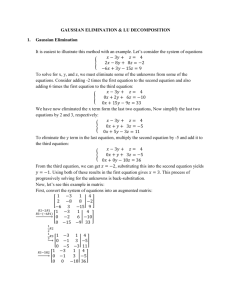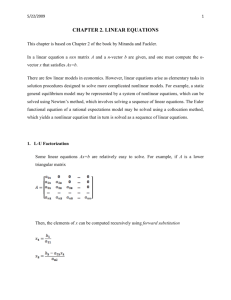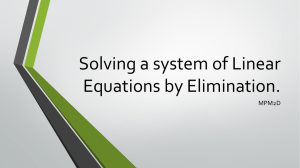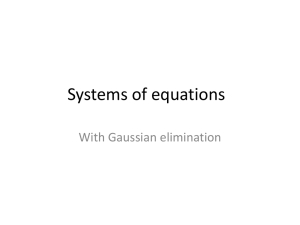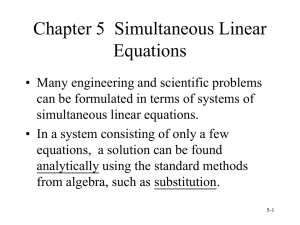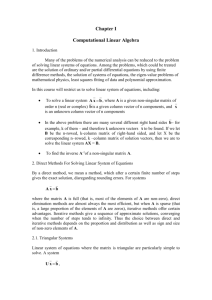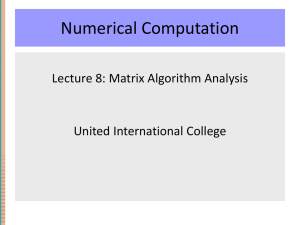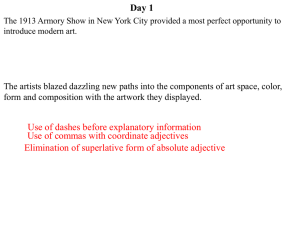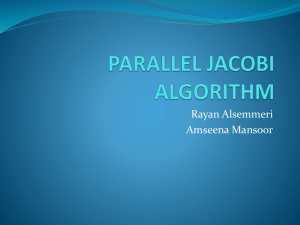Slides (PPT eng)
advertisement
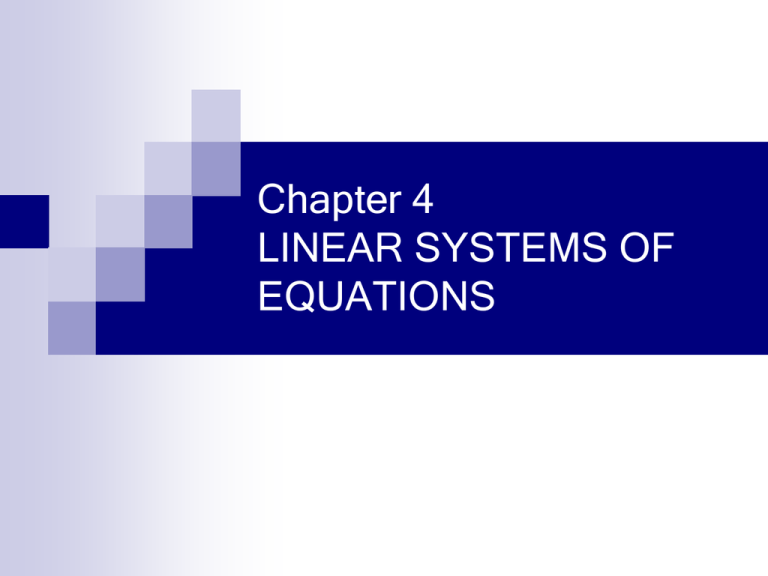
Chapter 4
LINEAR SYSTEMS OF
EQUATIONS
Linear systems of equation are associated with many
problems in engineering and science, as well as with
applications of mathematics to the social sciences and the
quantitative study of business and economic problems
E.g., to calculate the net flow of current through each junction
of an electrical circuit
4.1 Techniques for Solving Linear Systems of
Equations
A system of n equations with n unknown variables:
In the matrix notation:
(4.1)
(4.2)
where
If the reverse of A exists (A-1), then
(4.3)
The reverse matrix
(4.4)
where |A| is the determinant of A, Adj(A) – adjoint of A matrix
The adjoint of a square matrix A is the matrix whose (i,j)-th entry is the
(j,i)-th cofactor of A
The (j,i)-th cofactor of A is defined by a'ij = (-1)i+j|A|(i|j), where A(i|j) is
the submatrix of A obtained from A by deleting the i-th row and j-th
column.
Two basic classes of solving methods: direct and iterative
Direct methods : assume that the exact solutions exists and find the
precise solution in a final number of steps
Gauss-Jordan method (simple and accurate)
Gaussian elimination method (calculatively efficient)
Cholesky method (in case of nonsingular symmetrical matrix)
Iterative methods : starting from some initial approximation value,
construct a series of solution approximations such that it converges to
the exact solution of a system
Jacobi method
Gauss-Seidel method
SOR (Successive Over-Relaxation) method
Table 4.1 Methods for solving first-order linear systems of equations
4.2 Gaussian Elimination
4.2.1 General Gaussian Elimination
Consider the system of n linear equations with n unknowns
(4.5)
Start with transforming system (4.5) to upper triangular system of eq’s
Ax = b Ux = b*
(4.6-4.7)
where b* – n+1-dimensional vector, U – upper triangular matrix nxn:
(4.8)
Forward elimination:
Step 1 :
Eliminate x1 from all the equations of system (4.5) starting from the 2nd
one
with a11 ≠ 0
as a result
(4.9)
Forward elimination:
Step 2 :
Eliminate x2 from all the equations of system (4.9) starting from the 3rd
one
with a22 ≠ 0
as a result
(4.10)
Forward elimination:
Step n-1 :
Triangle system of linear equations
(4.11)
akk(k-1) – pivot element
Elimination with backward substitution:
In system (4.11) starting from nth equation, with ann(n-1)≠0
Substituting it to (n-1)th equation
Continuing this process, we obtain for each i = n-2, … ,1
(4.15)
General
Gaussian
elimination
procedure
4.2.2 Method of Pivot Selection (Pivoting)
Gaussian elimination: assumption that pivot element akk(k-1)≠0
However, that is not always so impossibility of computational
calculations; growing of the calculation error need to avoid that
In the method of forward substitution:
When one of the pivots akk(k-1) is zero, interchange the kth row with the
mth row, where m is the smallest integer greater than k for which amk(k-1)
is nonzero.
Pivoting procedure
Gaussian elimination procedure
Gaussian
elimination
procedure
4.3 Gauss-Jordan Method
Modification of Gaussian elimination
Gaussian elimination: transforming the initial system to upper triangular
system of eq’s Ax = b Ux = b*
Gauss-Jordan elimination: the final system is
Ix = b**
(4.16)
where I is the identity matrix of nth order, with elements δij = 1 if i = j δij =
0 otherwise
the final system is x = b**
Gauss-Jordan method procedure
4.4 LU factorization
Gaussian elimination: principal tool in the direct solution of linear
systems of equations
The steps used to solve a system of the form Ax = b can also be used
to factor a matrix into a product of matrices (factorization)
The factorization is particularly useful when it has the form A = LU,
where L is lower triangular and U is upper triangular
we can solve for x more easily in two-step process.
Suppose that Gaussian elimination can be performed on the system Ax
= b without row interchanges (i.e., pivot elements akk(k-1) are nonzero for
each k = 1,2,…,n
Consider the system
(4.17)
(4.18)
(4.19)
LU factorization (triangular factorization):
find y first from Ly = b
using Gaussian backward elimination find the solution from Ux = y
Two kinds of factorization:
Doolittle method requires lkk = 1 (k = 1,…,n)
Crout method requires ukk = 1 (k = 1,…,n)
Consider Doolittle method condition, lkk = 1. The elements of A:
When k = 1, we can find
When k = 2, we can find
here if we denote
then
On the kth step we can find kth row of U and 4th column of L
(4.20)
(4.21)
(4.22)
(4.23)
Repeat the process up to n times
If akk(k) = 0 apply pivoting for ajk(k) (k≤j≤n)
LU factorization procedure
4.5 Modified Cholesky Method
System of linear equations nxn:
Ax = b
A – symmetric matrix (necessary)
Doolittle method: A = LU; L – lower triangular with lii = 1, U – upper
triangular
Further:
U = DR
(4.24)
D – diagonal matrix nxn, R – upper triangular matrix with rii = 1
A = LDR = (LDR)T (because A – symmetric)
L = RT
A = RTDR
(4.25)
RTy = b, DRx = y
(4.26)
- we can find x using Gaussian elimination with backward substitution
Modified Cholesky method procedure
4.6 Iterative Methods
An iterative technique to solve the linear system Ax = b starts with an
initial approximation x(0) = (x1(0), x2(0), … , xn(0))T to the solution x and
generates a sequence of vectors {x(k)}∞k=0 that converges to x
The process stops when x(k) is sufficiently close to x; x(k) is the solution
of the system
Sopping criterions
ε – small enough positive constant
Below: summary of some other methods
No matter which method is used, the recurrence formula is
(4.29)
Depending on what ei(k) is, there are Jacobi, Gauss-Seidel, SOR and
other methods
4.6.1 Jacobi Iterative Method
In Jacobi method the components of x(k) are used in ei(k)
(4.30)
Sufficient condition for converging
(4.31)
4.6.2 Gauss-Seidel Method
An improvement to Jacobi method
Jacobi method: to compute xj(k), the components of x(k-1) are used
xj(k+1) (j = i+1, … ,n) have already been computed and are likely to be
better approximations to the actual solution more reasonable to
compute x(k) using the most recently calculated values
(4.32)
- Gauss-Seidel iterative technique
4.6.3 SOR (Successive Over-Relaxation) Method
Relaxation method: use the improved value of the difference between
xj(k+1) (obtained by Gauss-Seidel method), and xj(k)
(4.33)
w – relaxation coefficient
0<w<1: under-relaxation methods (can be used to obtain convergence
of some systems that are not convergent by the Gauss-Seidel method)
1<w: over-relaxation methods (used to accelerate the convergence for
systems that are convergent by the Gauss-Seidel technique) – SOR
method
w=1: same with Gauss-Seidel method
Usually: 1<w<2
